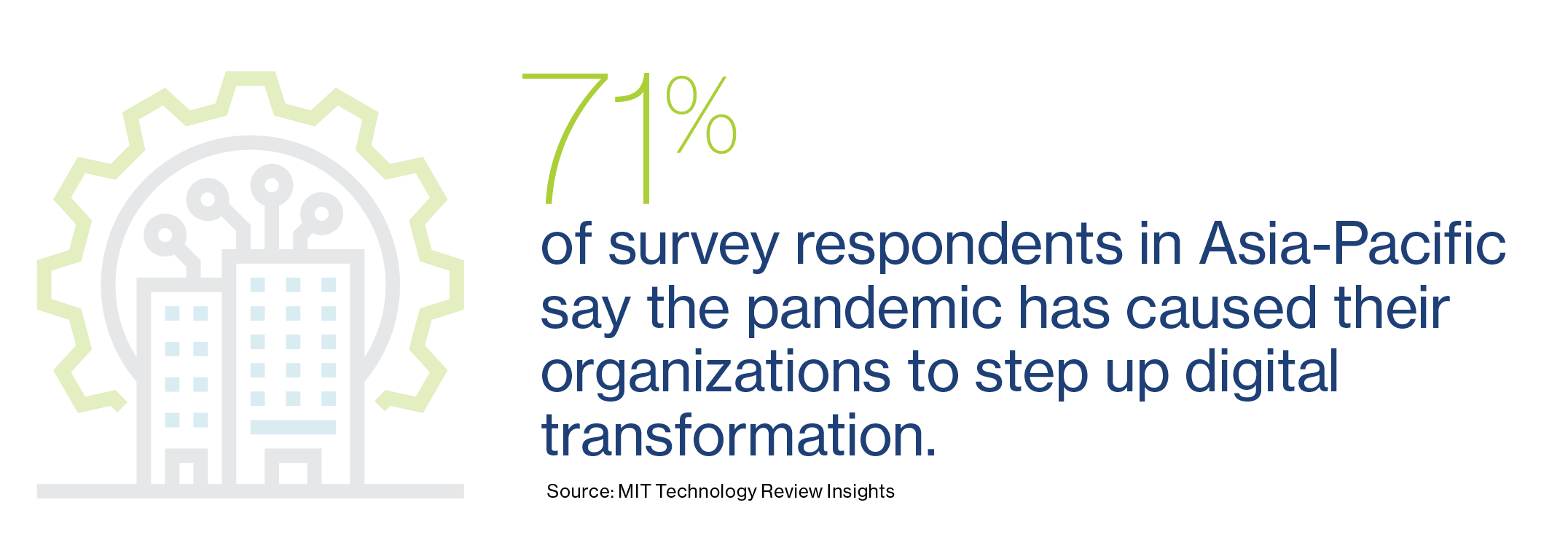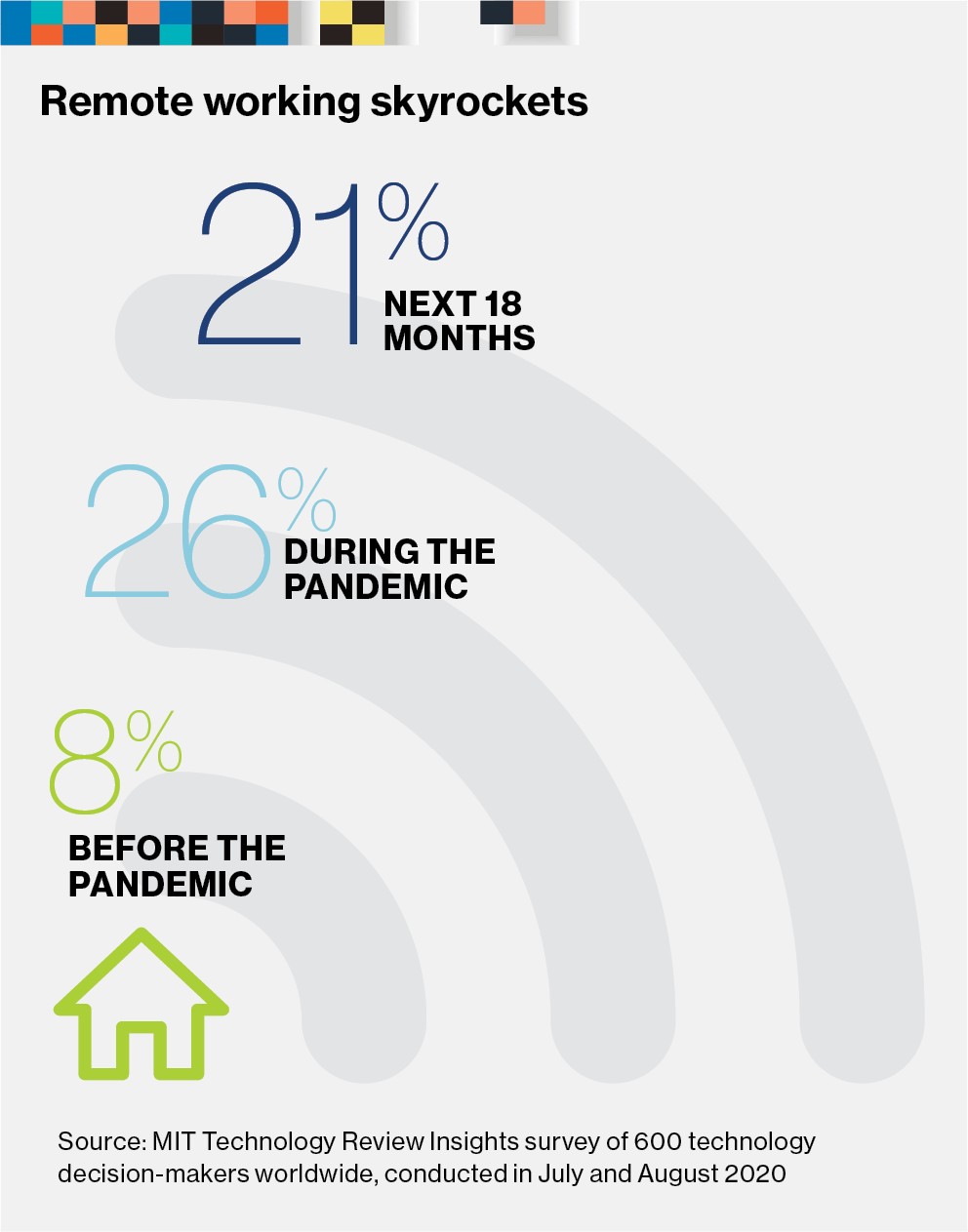Digital acceleration in the time of coronavirus: Asia-Pacific
This MIT Technology Review Insights report is part of a series examining the degree to which business preparedness, particularly in technology strategy, contributed to corporate resilience during the ongoing coronavirus pandemic in three world regions: Asia-Pacific, Europe, and North America. Based on survey research and in-depth executive interviews, the series also seeks to understand how technology priorities are changing as a result of ongoing business-continuity efforts.
Asia was the first world region to see the spread of the novel coronavirus, and as such it was the first to feel the disease's disastrous impact on its societies, its economies, its ways of life. As businesses were closed, and office workers sent to their homes, Asia-Pacific retailers, banks, manufacturers, and government agencies were also the first to try to effectively manage the crisis, putting IT infrastructures across the region to the test.

A global survey of 600 technology decision-makers conducted by MIT Technology Review Insights, in association with VMware, finds that most organizations in Asia-Pacific and the world over had largely prepared for the online commerce and remote working the pandemic made compulsory. More than three quarters of Asia-Pacific organizations had made digital and IT investments-and their efforts augmented their collective ability to handle new ways of doing business.
Six out of 10 Asia-Pacific respondents indicate they had business-continuity plans in place, although less than half consider them effective. By contrast, organizations that had heavily invested in digital transformation-incorporating modern technologies in processes and strategies to achieve business goals-universally found that their plans worked. These digital leaders," as we refer to them in this study, have built robust digital foundations to support the technologies they need to better respond to change.
We call ourselves a technology company," says Gautam Aggarwal, regional chief technology officer at Mastercard Asia-Pacific. We do not see our technology adoption as transformation' so much as it a continuous journey." He considers this mindset one of the key success factors that allowed Mastercard to operate normally during the pandemic. We have a strong growth infrastructure-both an external customer-facing network and internal corporate network. We also have a very comprehensive business-continuity plan behind our infrastructure-even if it has never been tested to this level before."
Digital leaders-before and during the crisisMore than 70% of survey respondents in Asia-Pacific say the pandemic has caused their organizations to step up digital transformation. Priorities have changed for all firms since the crisis-or rather, existing priorities have intensified," says Sanjay Poonen, chief operating officer at VMware. The pandemic has just altered the composition of the channels firms leverage, using the digital tools with which they are already familiar."

Jimmy Ng, group chief information officer and head of technology and operations at Singapore-based DBS Bank, recognized early on the strategic advantage of advancing digital capabilities. This early start on the journey has really helped us deal with this pandemic."
DBS's digital aspirations are codified in a program it calls GANDALF, an acronym combining the initials of the digital business giants it seeks to emulate-Google, Amazon, and Facebook, with the D representing DBS itself. The name derives from the powerful wizard in J.R.R. Tolkien's novels The Hobbit and The Lord of the Rings. The intention was twofold," says Ng. First, to learn from the best of the technology companies and bring the best of their practices into the bank. Second, we wanted to ensure that we actually operate like a technology company rather than a bank."
The initiative enabled specific pandemic-response capabilities that bolstered DBS's business resilience: When the bank saw the first covid-19 case among its workforce, Ng's team sprang to action. We used AI tools to ingest data from staff calendars, staff access data, and even staff use of Wi-Fi networks to do contact tracing up to three degrees of separation very quickly, building up models in a couple of days. This also informed how we developed protocols within the bank to stop the spread among employees," he says. The emergency protocols facilitated a multitude of efforts, sanitization guidelines, and the reorganization of team members across DBS facilities to enforce physical-distancing measures.

As the DBS and Mastercard testimonies confirm, digital tools have allowed organizations to nimbly respond to the new challenges of swiftly changing times-and, in general, be better prepared for them. Asia-Pacific digital leaders, who report substantial digital transformation progress, indicate that their organizations have more reliable technology planning as a result: 55% of Asia- Pacific digital-leader respondents, for instance, report that their 2020 IT budgets will be the same. At the same time, more than a third of Asia-Pacific respondents indicate that they are increasing their IT budgets, by an average of more than 10% over 2019 spending. This is reflective of efforts in the region to ramp up digital transformation: nearly four out of 10 respondents are increasing the adoption of mobile applications and moving to a cloud-first" development strategy-more than those from any other region.
Ng describes how the DBS digital infrastructure has achieved results: Today we are about 99% virtualized, and by the end of this year, over 90% of our entire legacy stack will have been transformed." For some time, the bank has pursued a mobility-first" concept for application development, which Ng points to as a key factor in the swift shift to remote working.
Download the full report.
This content was produced by Insights, the custom content arm of MIT Technology Review. It was not written by MIT Technology Review's editorial staff.